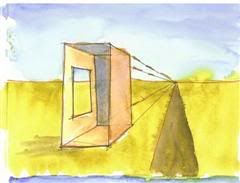6:9-11:32
This week we come to the story of the Noah and the flood. God becomes dissatisfiedwith the generation of the flood and all flesh on the earth, and thus plans to destroy them. But he does save one family, that of Noah, who was the most righteous of his generation. Noah is commanded to build an ark that will house male and female of every species and a few extra of the clean species. The floods come, everything is wiped out except what is on the Ark. God promises not to do that again, sealing the covenant with a rainbow. Noah, on the other hand, gets drunk and stupid. After the unpleasantness of this incident, a few more generations are born. With only a rainbow as a contract, these later generations don't completely trust god not to wipe them out too. They decide to make a tower at Babel to prevent this sort of thing from happening again. God intervenes,and soon no one can communicate with one another. These peoples are scattered across the world, becoming the various nations of the world. Following the genealogy of Noah's son Shem, we end introduced to some interesting characters: Abram, his wife Sarai, and his nephew Lot.
We read about the rainbow:
11. And I will establish my covenant with you; nor shall all flesh be cut off any more by the waters of a flood; nor shall there any more be a flood to destroy the earth.12. And God said, 'This is the sign of the covenant which I make between me and you and every living creature that is with you, for everlasting generations; 13. I set my bow in the cloud, and it shall be for a sign of a covenant between me and the earth. 14. And it shall come to pass, when I bring a cloud over the earth, that the bow shall be seen in the cloud; 15. And I will remember my covenant, which is between me and you and every living creature of all flesh; and the waters shall no more become a flood to destroy all flesh. 16. And the bow shall be in the cloud; and I will look upon it, that I may remember the everlasting covenant between God and every living creature of all flesh that is upon the earth.'
Many people find a dichotomy between science and religion. Funny thing is that dichotomy seems meaningless to many early western european theologians. One of the earliest people to accurately describe rainbows through the use of experimentation was the Dominican Theodoric of Freiberg in the early 14th century, who even accurately described double rainbows. One of the major findings of this early experimental work was if one were to take a light source, an observer and a water droplet (simulated by a glass flask), then if there is a 40°-42° angle between the light sources and the observer, the water droplet will reflect and refract in a way splitting out the colors of the rainbow. Between the 50-53 degree angles, we get the double rainbow.
Of course there's the song written by Paul Williams, and sung by the great green entertainer Kermit the Frog, which begins:
Why are there so many songs about rainbows,
And what's on the other side?
Rainbows are visions, they're only illusions,
Rainbows have nothing to hide
So we are told and some chose to believe it,
I know they're wrong wait and see,
Someday we'll find it, the Rainbow connection,
The lovers, the dreamers and me.
I feel the same way about rainbows, while knowing the science I'm always in awe of the sight of the rainbow. The idea that on a 41 degree angle between me, the brightly shining sun, and the thunderstorm that just drenched me creates such a wonderful phenomenon just means that God wove such a sight into the fabric of the universe. The rabbis of the Mishnah in a sense agree, that the rainbow is one of the miracles created at the last seconds of creation:
Ten things were created on the eve of the Sabbath at twilight, and these are they: [i] the mouth of the earth, [which swallowed Korach][ii] the mouth of the well,[which provided water during the Exodus] [iii] the mouth of the she-ass, [which talked to Balaam][iv] the rainbow, [v] the manna, [vi] the rod [of Moses], [vii] the shamir,[a creature which silently cut the stone blocks of the temple] [viii] the text, [ix] the writing, and [x] the tables.[of the Ten Commandments.. there's a whole drash there] [Avot 5:6]
The rabbis, who believed everything was created during the seven days of creation, came up with this explanation that miracle objects were actually woven into creation at the last minute. But this is not the only place that rainbows are mentioned. The major source of the early rabbi's commentary on the text is found in Midrash. There are many volumes of Midrash, but the most known is Midrash Rabbah, the Great Midrash. In Genesis Rabbah we read about rainbows:
I set my bow [Gen 9:14] my likeness, a thing that is comparable to me. Is it possible? But rather [like] straw to grain.
When I gather cloud on the earth [Gen 9:16], R. Judan in the name of R. Judan b. Simon [What is this compared to?] To one who has in his possession hot wax (or axe) who seeks to give it against his son but gives it against his servant [instead]. [Gen R. XXXV:3]
Once again, while the idea can be seen in the English, there is a lot of the meaning lost in the translation. We have here two ways of dealing with textual issues. The first is by wordplay. Hebrew at that time was not written with vowels, they were assumed. The Midrash takes the word for my bow Q-Sh-T-Y, and adds two more letters Q-Y-Sh-V-T-Y, which is the word for my likeness. Before one starts screaming FOWL! About changing text like that, one has to understand the nature of the Yud (Y) and Vav (V). Both are known as semi-vowels. At times they are used as vowels. The Yud is used as one form, known in Latin as plene of the long E sound as in the word English. The vav can be used either for the long O of Omaha, or the OO of lOOk. Thing is there are other ways called defectiva where the vav and yud can be missing and have the same using other vowel markers which would be invisible in an unvocalized text. The rabbis took the defectiva word, and made it plene, then read it, coming out with this idea of a likeness.
But of course, that's problematic. We don't have a likeness for God. Making likenesses are forbidden by the Ten Commandments, and more likely than not we would die from looking at the likeness of God anyway. So there is an objection. The objection is resolved by another word play now changing the word for rainbow into Q-Sh-Y-N. Q-Sh is the word for straw. Thus a rainbow is like God in the same way straw is like the edible grain - A pale reflection.
The rabbis liked metaphors and descriptive stories, and the second part of this Midrash points out another very common device used throughout rabbinic literature, the mashal. In its full form one might see the phrase A Parable. To what is this compared to? To…. Yet there are many variations of this phrase leaving out words hear or there. In our verse, it is reduced to the smallest form, just the word To. The rabbis use a parable of a man who is angry with his son, and is going to punish him in a very painful and brutal way. Our modern texts are not completely clear about exactly how, as one word could be translated as hot wax, or as a hot axe. But instead, the man metes the punishment out on a hapless servant instead. The son is spared the punishment, but sees the result of the anger. Of course in the
parable the man is God, the son is the Jewish people, and the hapless servant is the rainbow.
The midrash is an anthology, and thus multiple contradictory opinions can be right next to each other. This is the situation here for example, where we have two differing points of view on rainbows. In one, we have the rainbow as a likeness of God, however pale that might be. On the other, we have the rainbow as the place God metaphorically spills out his anger, one which other rabbis would use as a metaphor that anyone God is angry at has seen a rainbow. Only the very righteous have never seen a rainbow, because God has never been angry at them.
Iv'e seen rainbows, so I guess I'm not among the righteous. Actually, I'm a big fan of rainbows, often stopping everything I'm doing to go see if there is one. After any big storm, when the sun suddenly begins to shine, I'm out the door. Sometimes, if there is a sudden storm, while the storm is still raging, I'm checking my watch, to see if we are late enough in the day to have that important 40 or 50 degree solar angle. Some chase tornadoes, I chase rainbows. There are many reasons I do. One is that I am color blind, I can only see strong color: the more bold the color, the more I can see. Pastels are completely meaningless to me. Rainbows, perfect hues, contain such colors. But the other reason is one more rabbinic hermeneutic - actually #1 among the 13 of Rabbi Ishmael - a qal v'homer, or a fortiori reasoning. If a lesser case is true, according to reasoning by qal v'homer, then a greater case is so much more the case. If a brilliant, awe inspiring rainbow is like straw, a pale imitation of grain, then how much more so is the Glory of God brilliant and awe inspiring? What can this be compared to? To a righteous king who when walking by a bush, snags and tears his beautiful talit on it. When a beggar goes to sit under his bush he finds the corner of the garment, affirming the presence of a king he has never seen.
When I looking up into a dark sky with the sun behind me at forty-two degrees, and see one of the few colors I can see, the brilliant blue thread in an arc across the sky, I know the rainbow for me is God's tzitzit, reminding me to do the mitzvot.
That is the rainbow connection.








 I imagined the woman was on a patio similar to the one I once dined on in Kona, Hawaii at sunset. But that railing looked bad, and detracted for the picture. So I decided to add perspective to my paintings, and that got me thinking too.
I imagined the woman was on a patio similar to the one I once dined on in Kona, Hawaii at sunset. But that railing looked bad, and detracted for the picture. So I decided to add perspective to my paintings, and that got me thinking too. 
 As can be seen by the two blocks in the illustration, this is a little more realistic in rendering, yet it is more difficult to do. In this case the vanishing point to the left is not even on the page, and trying to keep all the lines straight is not easy. But still, it looks better than the one vanishing point.
As can be seen by the two blocks in the illustration, this is a little more realistic in rendering, yet it is more difficult to do. In this case the vanishing point to the left is not even on the page, and trying to keep all the lines straight is not easy. But still, it looks better than the one vanishing point.